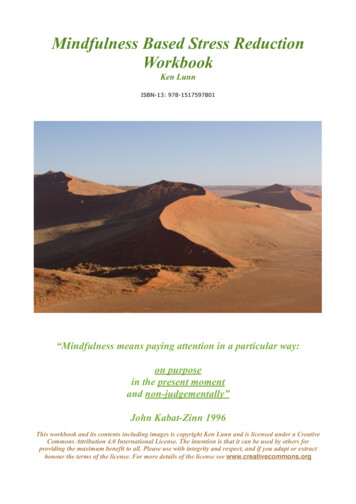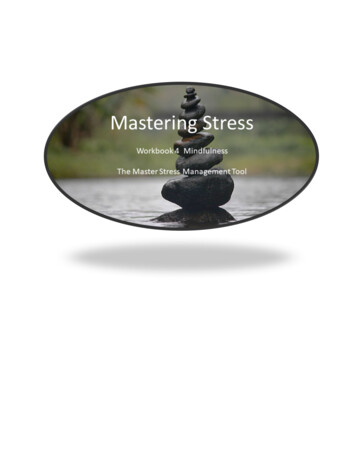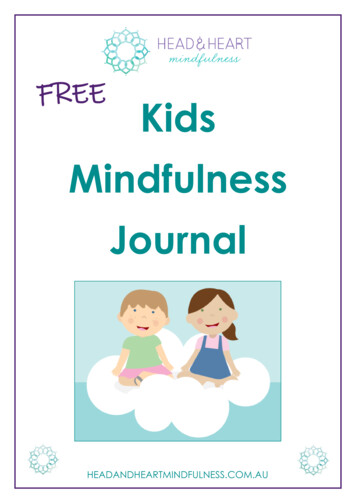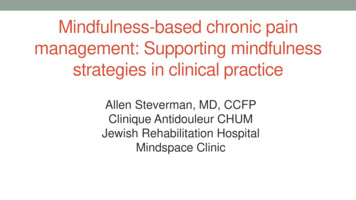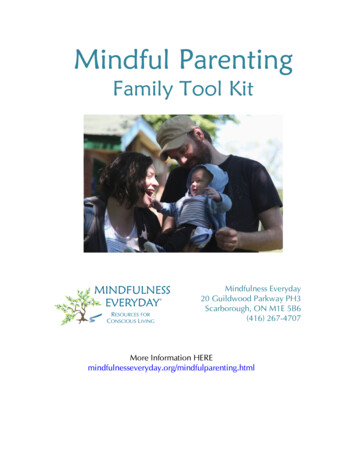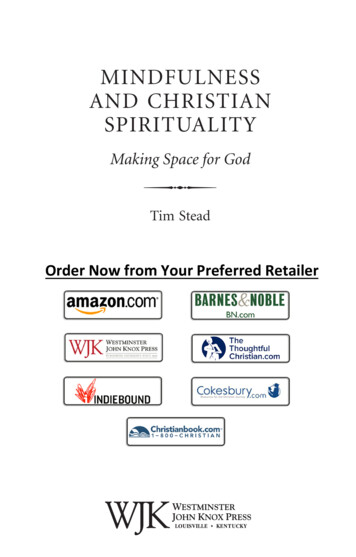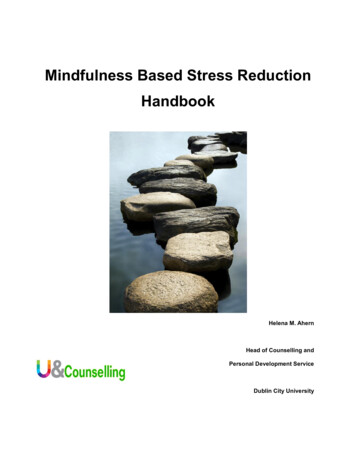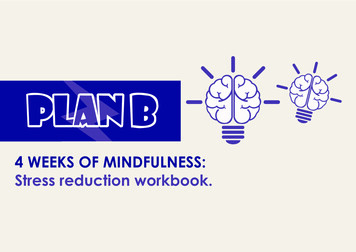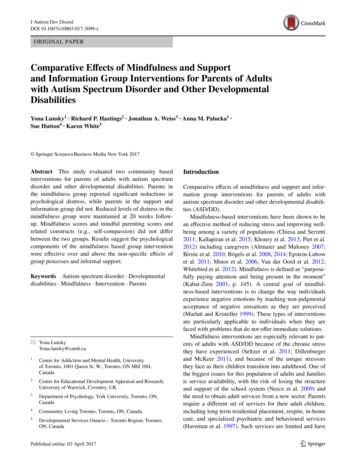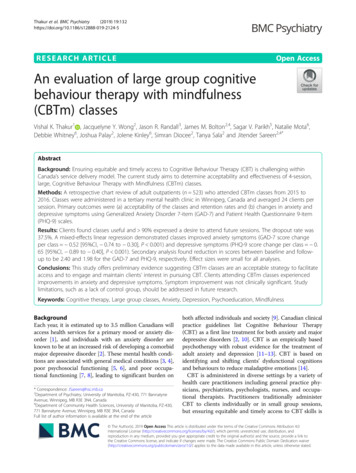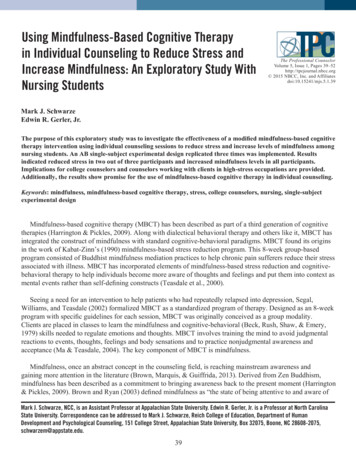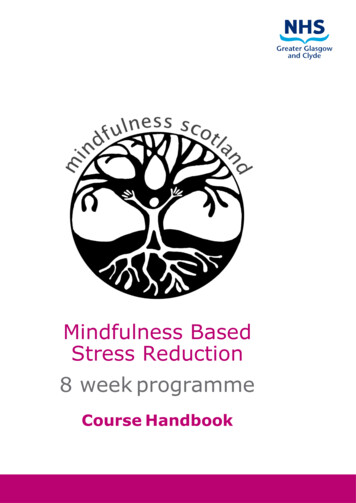
Transcription
Mindfulness BasedStress Reduction8 week programmeCourse Handbook1
Mindfulness is a turning towardslife . To live life as if each momentis important, as if each momentcounted and could be workedwith, even if it is a moment of pain,sadness, despair or fear.Jon Kabat Zinn Full Catastrophe Living2
Mindfulness ApproachesCourse HandbookWelcome to this course handbook. This will accompany you during theeight week course and contains notes, diaries, quotes and readings toprovide a background and support to your learning.You may find it helpful to read the relevant session notes after taking part in thatsession, and you will find diaries for recording your reflections and specifichomework tasks.We would recommend that you do not read ahead to enable you to experience eachsession fresh, without any prior expectations. It can also be helpful not to get tooinvolved in reading for the duration of the course, as this can move us into more of acognitive or thinking mode of processing, which may interfere with the experientialprocess.We will suggest some reading materials, and you may wish to reserve those untilthe end of the course. Alternatively, you may find that it can enrich your learningexperience if you chose to read perhaps one or two pages or re-read some ofthe poems we will be using, and to use these for reflection.This handbook will serve as a future reference point, as a memory book of what we willcover, and catalogue of resources which you can follow up at a later stage. It can alsoserve the purpose of a journal to chart your reflections throughout the course and thusdeepen your learning.We hope that you experience an enriching journey of transformation and discoverywith us over the coming weeks.Charlotte ProcterAlistair WilsonJuly 2008This version of the Mindfulness Scotland workbook was adapted in 2017 from the originaland offered for use by NHS GG & C MBSR teachers as part of the staff wellbeing initiativeled by the Health Improvement team, in collaboration with Mindfulness Scotland.Mindfulness Scotland have kindly granted permission for its publication in this form via the NHSGG&C Mindfulness App. It cannot be used with other groups, or by other teachers withoutpermission.3
ContentsWelcome, Introduction, Intention . 3Definitions of Mindfulness . 9Session One: Beginner’s Mind . 11Session Two: Overcoming Obstacles and Non-striving . 17Session Three: Staying Present . 29Session Four: Staying with what is Difficult . 40Session Five: Working with Thoughts and Emotions . 48Session Six: Day of Silent Practice . 54Session Seven: Lifestyle and Diet . 62Session Eight: Ending, Letting Go and the Rest of Your Life . 69Reading Materials and Resources . 754
Guidelines for Participationand PracticeBackground and aimsThis eight week course is based upon the programmes of Mindfulness Based StressReduction, developed in the United States by Jon Kabat Zinn, and Mindfulness BasedCognitive Therapy, developed in the UK and Canada by Mark Williams, John Teasdaleand Zindel Segal. It is also built up from our own personal experiences of mindfulnesspractice and we hope that it will provide rich sources of inspiration for you.The aims of the course are to help you to develop an in-depth personal experience ofmindfulness and to build the foundations of a sustained personal practice, with a viewto applying this in your life and perhaps also in your professional work.The course is primarily experiential, and we would like to invite you to immerse yourselfas best as you can into this process. This means adopting an attitude of curiosity toyour experience in the moment and suspending judgment as to whether or not youthink these approaches will work for you. It means letting go of opinions and ideas, andputting aside for a while any plans you may hold about applying these skills in apersonal or professional capacity when you have finished the course.Preparation and attendanceWe would very much like to encourage you to attend all of the group sessions, if at allpossible. You are invited to wear loose and comfortable clothing for the course,appropriate for some gentle body movement and stretching. If you already use ameditation bench, stool or cushions, you are welcome to bring them along with you.There will be chairs we can use and yoga mats for the stretching and floor exercises.If you are concerned about your health or ability to engage in some gentle stretchingand floor based exercises based upon yoga, we would advise that you discuss thiswith your GP and that you are able to work safely within your own limitations, optingout of any exercises which you do not feel confident about. However, these exerciseshave been developed in programmes for people with a variety of health conditions,and will be relatively gentle. The primary aim is to practice movement with awarenesswhilst being fully sensitive to our body’s needs in the moment.We would like to suggest some background reading, although would caution againstreading taking the place of practice as it can move us too much into thinking ratherthan experiencing. Reading one or two pages at a time may inspire us and supportour practice, or you may choose to read nothing until the end of the course, allowingthe experience to resonate deeply on its own. Please see the list of ‘reading to getyou started’ at the end of this manual for some suggestions.5
Personal practice and attitudesWe would like to remind you of the importance of personal practice and a commitmentto around 30 – 40 minutes of daily mindfulness practice for the duration of this course.The more you are able to put into the course, the more stable your practice will feel atthe end and the more confident you will feel about taking these approaches forward intoyour life.It can be challenging to change our habits and to practice a new skill. We may find itdifficult to carve out a regular practice time, and may need to negotiate with family,friends or colleagues to ensure that we protect this dedicated space and time, free fromthe distractions of everyday life.We may find that, at times, we strongly resist this change in emphasis and habit in ourlives, however strong our intention may be to develop these skills. We may notice ourattempts to avoid the opportunity to practice, to find countless reasons why not to, andendless lists of other more important things which demand our time. We may find thatwe struggle with being quietly in our own company without distractions and without anyobvious agendas; we may feel bored; we may fall asleep! We will notice how theordinary mind is so used to distraction and dulled awareness and how much it resistschange.So, it is important to remind ourselves of why we are doing this in the first place andwhat our intentions are. This can provide a sense of direction and purpose which canpropel us forwards, if ever we encounter difficulties or if our commitment wavers. Youmay find it helpful to reflect on the questions below before starting the course. You canlook back to your responses as you progress as a reminder of your intention.It is helpful to adopt an attitude of curiosity and open mindedness for the duration ofthe eight weeks, and to suspend judgment as to whether or not this will work for you.At the end of the course, you can reflect and make your own decision as to whether ornot you will continue with the practices you have learned.You will benefit from commencing this journey with the spirit of patience andcommitment. This means not knowing what the outcome will be, or what will unfold, buttrusting in the practices you are engaging in. It also means persevering, even whenyou feel you are making no progress or when things feel difficult.Jon Kabat Zinn has described these practices as like “weaving a parachute”. Wedon’t want to start practicing when we are in difficulty and need to jump out of theplane. We want to be weaving the parachute day and night, just hoping that when weneed the support of mindfulness practice, it has a better chance of supporting us.6
What is my intention?What is my intention or purpose in engaging in this course?What do I hope for, for myself?How do I want this to change the way that I live my life?How do I want this to benefit the people in my life and in the world?What are my deepest hopes and aspirations?Can I express this in the form of a personal vow or aspirationwhich communicates my whole-hearted intention?7
What is mindfulness?Mindfulness is a life skill which can deepen our sense of well-being and fulfillment. Itinvolves paying attention to what is occurring in our present moment experience, withan attitude of openness and non-judgmental acceptance. It engages all of our sensesas we open to our entire experience, becoming aware of our body, emotions, thoughtsand the external environment.It is about “coming back to our senses”, being in touch with ourselves, with othersand our surroundings in the present moment. It is a natural and an intuitive state ofpresence in which we can feel more connected, real and alive.Mindfulness is a state of being which is accessible to every one of us. It is also a skillwhich we can cultivate more deeply in our lives. Some experience of mindful presencewill have been felt by all of us during some moments of our lives, but perhaps we didnot know what is was when we experienced it.Perhaps we have felt this in more peaceful moments, when we have been present inplaces of natural beauty, and simply “breathing it in”, whether this was a beautifulsunset or standing next to the sea or a waterfall. Perhaps we have felt this in someheightened moments, being with a loved one, during the birth of a child, or even beingpresent with someone who is dying. These are the moments we may be more likely toremember and are less likely to be distracted by other more trivial concerns. Maybe wehave just felt qualities of such mindful presence when we have been fully engaged in anactivity which we love, playing a musical instrument, dancing, riding a horse, or sittingon a sunny plaza on holiday, sipping a cappuccino.We will be aware that this is not perhaps our usual mode of operation. During ourstressful lives, our attention is usually dispersed. We are usually busy juggling anumber of tasks and pre-occupations at the same time, and none of our actions orthoughts receives our full attention. We are usually leaping stressfully from one thing tothe next, like a monkey in a tree, grabbing at things that interest us or demand ourattention, then drifting on to something else, being distracted, day-dreaming, beingcaught up in our thoughts and worries about what happened yesterday and what weneed to do tomorrow, only giving things half of our attention, not hearing fully what issaid to us, pre-occupied with our own issues and concerns, judging our experiencesconstantly as good or bad according to our own preferences and often reacting againstthe way things actually are. This is our ordinary state of mind and not exactly apeaceful one. We can spend a good part of our lives like this, not being fully presentand therefore missing most of the moments in which we live.This habitual state of mind and being is unfortunately very familiar to us. We find weare living our lives on a sort of automatic pilot, relatively ungrounded, cut-off, out oftouch with ourselves, our bodies and emotions. It sometimes feels as if we are “living inour heads” and our bodies are just vehicles for getting us around. Our stressful livescertainly contribute to this way of being, but when it becomes our habitual state, it canalso be associated with a number of stress related health problems. Learning toreverse these habits and to cultivate positive ways of being will be greatly beneficial inmaking our lives happier and more wholesome.8
When we can get in touch with qualities of mindfulness, we will feel a sense of comingback home to ourselves in a more meaningful way. We may find we can get in touchwith a sense of brightness, clarity of purpose, playfulness, creativity and inner peace. Itis said that mindfulness practitioners develop a more optimistic stance in their lives, anda courage which enables them to work with rather than avoid life’s challenges.Certainly, mindfulness is not just about having more blissful moments, it is about beingmore fully present in our lives, remaining curious, embracing all of our experiences, andmost importantly, changing the relationship we have towards our suffering.Definitions of mindfulnessMindfulness means paying attention in a particular way, on purpose, in thepresent moment, and non-judgementally. This kind of awareness nurturesgreater awareness, clarity and acceptance of present moment reality. Itwakes us up to the fact that our lives unfold only in moments. If we are notfully present for many of these moments, we may not only miss what ismost valuable in our lives but also fail to realise the richness and the depthof our possibilities for growth and transformation.Jon Kabat Zinn, ‘Full Catastrophe Living’Mindfulness refers to keeping one’s consciousness alive to the presentreality. It is the miracle by which we master and restore ourselves.Thich Nhat Hanh, ‘The Miracle of Mindfulness’Mindfulness is a universal human capacity – a way of paying attention tothe present moment unfolding of experience – that can be cultivated,sustained and integrated into everyday life through in-depth inquiry,fuelled by the ongoing discipline of meditation practice. Its central aim isthe relief of suffering and the uncovering of our essential nature.Saki Santorelli, ‘Heal Thyself’Mindfulness is a turning towards life . To live life as if each moment isimportant, as if each moment counted and could be worked with, even if itis a moment of pain, sadness, despair or fear.Jon Kabat Zinn ‘Full Catastrophe Living’9
Triangle of awarenessWhen we experience an event with mindfulness, we can observe which of thesedomains of awareness is the strongest or the most dominant. We can try to create morebalance in our awareness by asking about the other domains and trying to be aware ofall three.ThoughtAwarenessEmotionSensationUseful poetry:If I Had My Life to Live Over, Nadine Stair (85 year old)The Summer Day, Mary Oliver, From New and Selected Poems, Boston, Beacon Press, 199210
Session one: Beginner’s mindSometimes, when mindfulness arises it can feel as if we are seeing things for the first timewith a freshness that can take us by surprise. This quality of mind has been referred to as“beginner’s mind”, and has some of the qualities of wonder and appreciation that a happychild can have in experiencing new things. When we walk past a tree, we are not stuck withthe concept of “tree” that we hold in our minds (“I know what trees look like”), instead, wereally see that particular tree with its blossoms, gnarled bark and unique individuality. In thisway, mindfulness can help us to engage more fully with life, with its sheer impact andbeauty, and can shake us from our habitual thinking, awakening a sense of awe andwonder. Even the most ordinary things can be seen with new eyes and we can appreciatethe uniqueness and preciousness of all things.When we are learning the practice of mindfulness, we are trying to foster this quality of“beginner’s mind”. A meditation teacher, Shunryu Suzuki, said that “in the beginner’smind there are many possibilities, in the expert’s mind there are few”. He wasdescribing how we can close down our experience when we think we know, when weengage in the world through our habitual thoughts and concepts and when we have ajaded sense that “we have seen it all before”.The raisin exerciseThis is an opportunity to awaken a sense of “beginner’s mind” by exploring an objectthat is very familiar to us, as if we have never seen it before! It shows us howmeditation practice can be very grounded in our every-day experience, in this case theact of eating. We practice opening up to this experience through our senses of sight,hearing, touch, smell and taste, and by slowing down in a way that we can pay closeattention to our experience.We notice something about how the mind is constantly trying to distract us frombeing present, with a variety of thoughts and comments, judgments about liking anddisliking, or how well we are doing, memories and associations, some of which canenhance the experience and some which pull us away.We can reflect on how different this experience is from the way that we normally eatraisins (mindlessly by the handful!). We can also reflect on the quality and intensityof the taste when we are really present to experience it.We may notice something about how we pay attention and the quality of awareness.There may be moments of dullness or distraction. There may be moments of clarity.Our perception of time may change in some way as we open up to the presentmoment of experiencing and tasting. We recognise that by paying attention we candeepen and enrich our moment by moment experience of living.11
Automatic pilotThe raisin exercise reminds us that most of the time we can be lost in a form of“automatic pilot”, in which we are not fully paying attention. We may be driven by ouragendas and habits of busyness without being fully aware of what we are doing. Wemay often be doing something and at the same time thinking of something else– perhaps worrying, or planning the next thing to do, judging or evaluating – literallybeing lost in thought, and less present in our real lives! We can actually lose significantchunks of our lives in this way, because we are not present for them. And, these arenot just moments, they are our life! If we miss these moments, we miss our life.When we are lost in automatic pilot, we are also unprotected – like a guard on dutyfalling asleep. We are more likely to “get our buttons pushed” and to respond in anunhelpful reactive manner. We are more likely to fall victim to our old habits of thinkingand behaviour, which can increase the risk of worsening mood states, whether that isanxiety and stress, anger or depression.With awareness, we can break out of these patterns and bring a more creativeresponse to our experiences. We will find that we have more choice as to how werespond. We can become more aware of our thoughts, our emotions and our behaviourand what experiences push us into reactivity. We do not have to be continually trappedby the same old “mental ruts” that have caused us problems in the past.The body scanIn the same way that we focused on the raisin, in this practice, we move our attentionaround the different parts of our body, as a means of anchoring ourselves in thepresent moment of sensing and experiencing. We will notice how complex the body is –a whole universe of sensation! The practice includes precise awareness of our detailedbody parts, the sensations on the surface of the skin, the feelings from inside the body,including sensations perhaps of body organs and bones and the integrated movementsof the breath through the body. We may notice sensations of discomfort, sensations ofintensity, or sensations which are so subtle or almost absent from our awareness. Wemay also become aware of emotional responses, thoughts or stories associated withdifferent body parts – our bodies have histories and our relationship to our body can becomplicated. In this way we can start to see how rich and illuminating this practice canbe.We may start to notice more about the different ways in which we pay attention and thedifferent qualities of awareness that are possible. We will learn about how attention canbe very flexible. At one moment, we are paying detailed attention to a small body part,such as our big toe. At other moments, we are holding larger areas of the body in ourawareness, such as both of our legs, from the ankles to the hips. We may start tonotice the differences in experience if we are holding a mental image of the body in ourmind’s eye (what we think our left arm looks like), or if we are just experiencing thepure sensations themselves.12
Our aim here is to stay with the experience of the body in the present moment, allowingsensations to flow in and out of our awareness, as best we can. There is no right or wrongway for things to feel – there is no expectation that we will even feel relaxed. This isdifferent to a relaxation exercise. We are just feeling what we are feeling, as much as wecan allow ourselves to.Through this practice, we start to notice a lot about the habits of the mind. Yes, we will getdistracted – many times! We start to notice that the mind is addicted to distraction! We maynot even notice that we are distracted for some time. But, when we do, we can congratulateourselves for noticing, and we can invite our attention back, however many times isrequired. We may notice that the mind does not really want to be present a lot of the time –we may even find that it falls asleep! Sleepiness is commonly experienced when peoplestart with this practice – perhaps we are just very tired, and we really notice this when westop all of our activity for a while. It may also seem strange at first to practice wakefulness inthis lying down position.So much can be experienced in the practice of the body scan, and it can be a difficultpractice for many people, especially if their relationship to their body and its history iscomplicated. If we choose to take forward this practice on a regular basis, we will start tonotice a positive shift in our relationship to our body, through enhanced body awareness,perhaps in the development of self-kindness, appreciation and gratitude for our body andwhat it does for us. We may find that we can develop a more positive response toexperiences of pain or suffering in the body and protect it from being the battle-ground ofour anger, resentment, frustration and judgmental responses. More than anything, ourbodies are the homes of our sensory organs, and it is through the felt sense of our bodiesthat we can deeply experience our lives.Practicing mindfulness of the bodyAs we continue to practice the body scan, we will find that we can enhance the awarenessof our bodies at different times during our day. We can bring awareness to our posture,being aware of what position we are in and what our bodies are doing at any given time. Wemay benefit from a brief body awareness scan, noticing any areas of tension and allowingthem to release. We could try to ground ourselves in the present moment by bringingawareness to our feet as they touch the earth, and noticing parts of the body in contact withthe furniture we rest upon. We could bring our attention to whatever tasks we are engagedin and notice how our bodies connect to those tasks through our senses: our sense oftouch, taste, smell, sight and hearing. These brief and grounding body awareness practicescan be invaluable at times when we are feeling stressed. They only take a few momentsand can bring us back in touch with ourselves.Any exercise, if practiced sensibly, can bring us into mindful awareness of our bodies. Thepractice of yoga and T’ai Chi can be particularly helpful in fostering a mindful bodyawareness. Even when we are walking, instead of focusing too rigidly upon our intendeddestination, we can allow our awareness to focus upon the sensations in the body andlimbs as we move.13
Mindfulness and eatingMindfulness is: Deliberately paying attention, non-judgmentally. Mindfulness encompasses both internal processes and external environments. Mindfulness is being aware of what is present for you mentally, emotionally andphysically in each moment. With practice, mindfulness cultivates the possibility of freeing yourself ofreactive, habitual patterns of thinking, feeling and acting. Mindfulness promotes balance, choice, wisdom and acceptance of what is.Mindful eating is: Allowing yourself to become aware of the positive and nurturing opportunities thatare available through food preparation and consumption by respecting your owninner wisdom. Choosing to eat food that is both pleasing to you and nourishing to your body byusing all your senses to explore, savor and taste. Acknowledging responses to food (likes, dislikes or neutral attitudes) withoutjudgement. Learning to be aware of physical hunger and satiety cues to guide your decision tobegin eating and to stop eating.Someone who eats mindfully: Acknowledges that there is no right or wrong way to eat but varying degrees ofawareness surrounding the experience of food. Accepts that his/her eating experiences are unique. Is an individual who by choice, directs his/her awareness to all aspects of foodand eating on a moment-by-moment basis. Is an individual who looks at the immediate choices and direct experiencesassociated with food and eating: not to the distant health outcome of that choice. Is aware of and reflects on the effects caused by unmindful eating. Experiences insight about how he/she can act to achieve specific health goals as he/she becomes more attuned to the direct experience of eating and feelings of health. Becomes aware of the interconnection of earth, living beings, and cultural practicesand the impact of his/her food choices has on those systems.The Center for Mindful Eating Free to reproduce and distribution for educationalpurposes only www.tcme.org or info@tcme.org 14
Home practice – Week oneBeginner’s mindFormal mindfulness practice Practice the guided body scan each day. Watch out for any expectations you may have about what “should” be happening andany obstacles or perceived difficulties getting in the way of your practice. Watch out forjudgments about getting it right, or about it not working. Try to suspend judgment. Simply come back to the practice – experience whatever youare experiencing – there is no right or wrong experience – just keep practicing it.Informal mindfulness practice Choose a routine activity each day that you can practice with mindful awareness. Youmay wish to choose an activity during which you are habitually rushing or un-aware. Thismight be something like, cleaning your teeth, taking your shower in the morning, takingthe dog for a walk, driving the car, washing up dishes, chopping vegetables for a meal.Whatever you choose, it can be helpful to focus on this same activity for the duration ofthe week. Practice coming into the present moment with all of your senses, fully engaged,as you take part in this exercise. Bring awareness to eating and look out for opportunities to practice eating in a mindfulmanner. This may be choosing to eat one meal with awareness – focusing on sensation,colour, texture, taste. Or perhaps you can choose to pay attention to one mindfulmouthful.Reflection and learning You may find it helpful to keep a practice log of your various practices and reflections.Use the home practice log on the next page to record your experiences, and to noteanything that comes up that you may wish to ask about at the next meeting. This is a personal record and doesn’t need to be shared.Finding time:Although you may benefit from longer practices, a shorter practice, or a couple of shorterpractices at different times are better than none at all.Remember to be gentle with yourself and let go of specific expectations15
Home practice logDuring your formal or informal practices of mindfulness, bring awarenessto physical sensations, thoughts and emotions and your responses tothem. Practice bringing awareness to distraction and note where yourmind habitually goes.Day/dateMindfulness practiceComments about what you noticed 16
Session Two: OvercomingObstacles and Non-strivingOvercoming obstaclesIt is always very interesting to explore the obstacles and difficulties which have come upover the week and to recognise how universal they are. This is all powerful learning aboutthe nature of the mind and the nature of our habitual tendencies. There is no need here fordespondency; it is all a learning process of becoming more aware and awake in our lives.We will be learning about working with distraction, with boredom, with sleepiness, withmanaging the demands in our life which seem determined to stop us from practicing. Wewill be working around these demands and working out how we can carve out a slot forthese practices. We will be learning perhaps how difficult it may be for us to engage inactivities with no obvious goal or purpose – a sort of “non-doing”, which may seem to ourjudging minds like an unearned luxury or waste of our time. We may find ourselves feelingfrustrated, because it is “not working”, or because “we cannot do it right”. Then, perhaps wecan remember that these are just thoughts!There is no right way and no wrong way. There is no “success” or “failure”. There is no suchthing as a “good” or “bad” mindfulness practice. There is just our experience, from onemoment to the next. Our job is just to notice! To let it be as it is, without trying to change ourexperience.If we have experienced any sense of struggle, it is probable that we have had someexpectations about how things should have been. And caught up in these expectations, it isvery likely there have been some judgments – self-judgments or judgments about thepractices. We can start to see how our expectations can lead to disappointmen
Mindfulness is a turning towards life . To live life as if each moment is important, as if each moment counted and could be worked with, even if it is a moment of pain, . This version of the Mindfulness Scotland workbook was adapted in 2017 from the original
